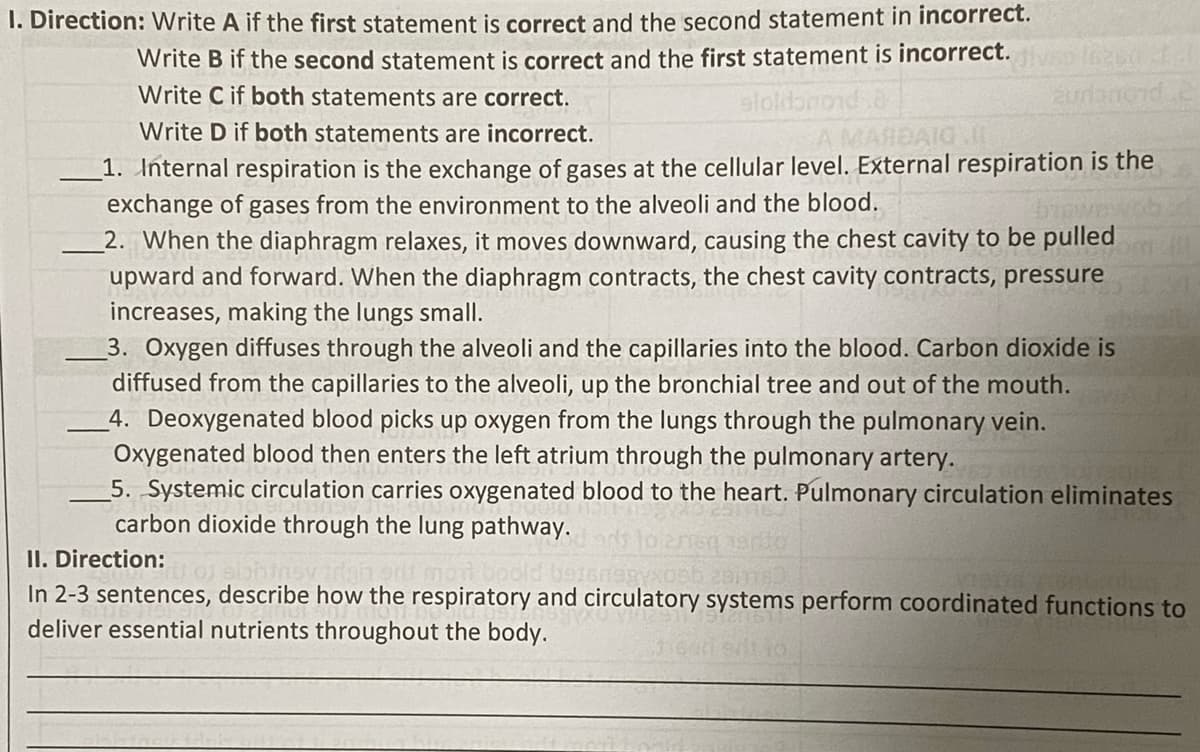I. Direction: Write A if the first statement is correct and the second statement in incorrect. Write B if the second statement is correct and the first statement is incorrect. Write C if both statements are correct. zurlangnd Write D if both statements are incorrect. 1. Internal respiration is the exchange of gases at the cellular level. External respiration is the exchange of 2. When the diaphragm relaxes, it moves downward, causing the chest cavity to be pulled upward and forward. When the diaphragm contracts, the chest cavity contracts, pressure increases, making the lungs small. 3. Oxygen diffuses through the alveoli and the capillaries into the blood. Carbon dioxide is diffused from the capillaries to the alveoli, up the bronchial tree and out of the mouth. _4. Deoxygenated blood picks up oxygen from the lungs through the pulmonary vein. Oxygenated blood then enters the left atrium through the pulmonary artery. 5. Systemic circulation carries oxygenated blood to the heart. Pulmonary circulation eliminates carbon dioxide through the lung pathway. gases from the environment to the alveoli and the blood. II. Direction: In 2-3 sentences, describe how the respiratory and circulatory systems perform coordinated functions to deliver essential nutrients throughout the body.
I. Direction: Write A if the first statement is correct and the second statement in incorrect. Write B if the second statement is correct and the first statement is incorrect. Write C if both statements are correct. zurlangnd Write D if both statements are incorrect. 1. Internal respiration is the exchange of gases at the cellular level. External respiration is the exchange of 2. When the diaphragm relaxes, it moves downward, causing the chest cavity to be pulled upward and forward. When the diaphragm contracts, the chest cavity contracts, pressure increases, making the lungs small. 3. Oxygen diffuses through the alveoli and the capillaries into the blood. Carbon dioxide is diffused from the capillaries to the alveoli, up the bronchial tree and out of the mouth. _4. Deoxygenated blood picks up oxygen from the lungs through the pulmonary vein. Oxygenated blood then enters the left atrium through the pulmonary artery. 5. Systemic circulation carries oxygenated blood to the heart. Pulmonary circulation eliminates carbon dioxide through the lung pathway. gases from the environment to the alveoli and the blood. II. Direction: In 2-3 sentences, describe how the respiratory and circulatory systems perform coordinated functions to deliver essential nutrients throughout the body.
Chapter17: Respiratory System
Section: Chapter Questions
Problem 1ATC
Related questions
Question
100%

Transcribed Image Text:1. Direction: Write A if the first statement is correct and the second statement in incorrect.
Write B if the second statement is correct and the first statement is incorrect.
Write C if both statements are correct.
aloldon
aurlanord.c
Write D if both statements are incorrect.
BARE
1. Internal respiration is the exchange of gases at the cellular level. External respiration is the
exchange of gases from the environment to the alveoli and the blood.
2. When the diaphragm relaxes, it moves downward, causing the chest cavity to be pulled
upward and forward. When the diaphragm contracts, the chest cavity contracts, pressure
increases, making the lungs small.
3. Oxygen diffuses through the alveoli and the capillaries into the blood. Carbon dioxide is
diffused from the capillaries to the alveoli, up the bronchial tree and out of the mouth.
4. Deoxygenated blood picks up oxygen from the lungs through the pulmonary vein.
Oxygenated blood then enters the left atrium through the pulmonary artery.
5. Systemic circulation carries oxygenated blood to the heart. Pulmonary circulation eliminates
carbon dioxide through the lung pathway.
II. Direction:
In 2-3 sentences, describe how the respiratory and circulatory systems perform coordinated functions to
deliver essential nutrients throughout the body.
Expert Solution
This question has been solved!
Explore an expertly crafted, step-by-step solution for a thorough understanding of key concepts.
This is a popular solution!
Trending now
This is a popular solution!
Step by step
Solved in 2 steps

Knowledge Booster
Learn more about
Need a deep-dive on the concept behind this application? Look no further. Learn more about this topic, biology and related others by exploring similar questions and additional content below.Recommended textbooks for you


Concepts of Biology
Biology
ISBN:
9781938168116
Author:
Samantha Fowler, Rebecca Roush, James Wise
Publisher:
OpenStax College

Essentials of Pharmacology for Health Professions
Nursing
ISBN:
9781305441620
Author:
WOODROW
Publisher:
Cengage


Concepts of Biology
Biology
ISBN:
9781938168116
Author:
Samantha Fowler, Rebecca Roush, James Wise
Publisher:
OpenStax College

Essentials of Pharmacology for Health Professions
Nursing
ISBN:
9781305441620
Author:
WOODROW
Publisher:
Cengage

Basic Clinical Lab Competencies for Respiratory C…
Nursing
ISBN:
9781285244662
Author:
White
Publisher:
Cengage

Comprehensive Medical Assisting: Administrative a…
Nursing
ISBN:
9781305964792
Author:
Wilburta Q. Lindh, Carol D. Tamparo, Barbara M. Dahl, Julie Morris, Cindy Correa
Publisher:
Cengage Learning

Biology: The Dynamic Science (MindTap Course List)
Biology
ISBN:
9781305389892
Author:
Peter J. Russell, Paul E. Hertz, Beverly McMillan
Publisher:
Cengage Learning